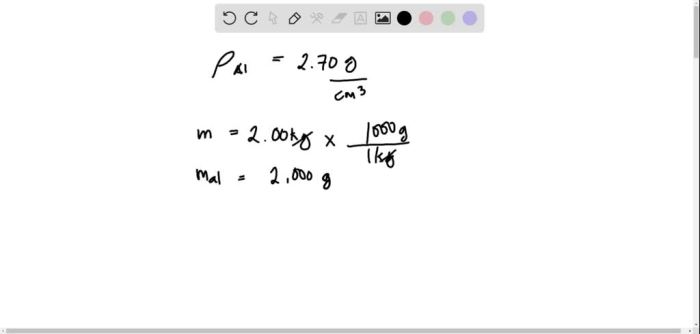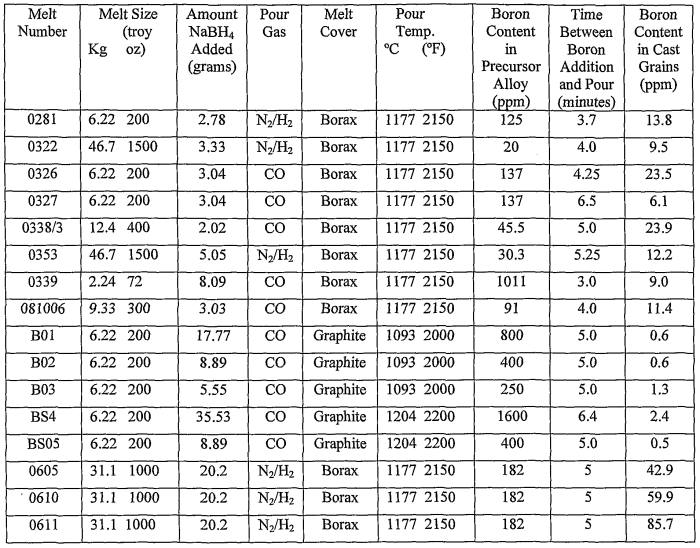The density of aluminum is 2.70 g cm3, a remarkable value that underpins the unique properties and diverse applications of this lightweight metal. This density not only defines its physical characteristics but also influences its behavior under varying conditions, making it a versatile material across numerous industries.
This comprehensive analysis delves into the significance of aluminum’s density, exploring its implications for the material’s properties, applications, and comparisons with other metals. By unraveling the intricate relationship between density and aluminum’s multifaceted nature, we gain a deeper understanding of this remarkable element.
Understanding Density: The Density Of Aluminum Is 2.70 G Cm3

Density is a crucial property of materials that quantifies the amount of mass contained within a given volume. It plays a significant role in characterizing and understanding the behavior of substances.
Mathematically, density (ρ) is defined as the mass (m) of a substance divided by its volume (V): ρ = m/V. The SI unit of density is kilograms per cubic meter (kg/m 3), but other units such as grams per cubic centimeter (g/cm 3) are also commonly used.
Density of Aluminum

The given value of aluminum’s density is 2.70 g/cm 3. This value indicates that for every cubic centimeter of aluminum, there is a mass of 2.70 grams.
The relatively low density of aluminum makes it a lightweight material, contributing to its widespread use in various industries.
Factors Affecting Density
Density can be influenced by several factors, including temperature and pressure.
Temperature:As temperature increases, the particles of a substance gain kinetic energy and move more vigorously, causing them to occupy a larger volume. This results in a decrease in density.
Pressure:Increasing pressure compresses the particles of a substance, reducing the volume it occupies. Consequently, density increases under higher pressure.
For aluminum, the effect of temperature on density is more pronounced than the effect of pressure.
Applications of Aluminum’s Density
The low density of aluminum makes it a highly sought-after material in various industries:
- Aerospace:Aluminum’s lightweight nature and high strength-to-weight ratio make it ideal for aircraft and spacecraft construction.
- Automotive:Aluminum is used in car bodies, frames, and engines to reduce weight and improve fuel efficiency.
- Construction:Aluminum’s corrosion resistance and lightweight properties make it suitable for roofing, siding, and other building components.
- Consumer Electronics:The lightweight and durable nature of aluminum makes it a preferred choice for laptops, smartphones, and other electronic devices.
Comparison with Other Materials, The density of aluminum is 2.70 g cm3
| Material | Density (g/cm3) |
|---|---|
| Aluminum | 2.70 |
| Iron | 7.87 |
| Copper | 8.96 |
| Titanium | 4.51 |
| Steel | 7.85 |
As evident from the table, aluminum has a significantly lower density compared to other common metals.
Impact on Material Properties
The low density of aluminum influences several of its other material properties:
- Strength:Despite its low density, aluminum is a relatively strong material, making it suitable for structural applications.
- Conductivity:Aluminum is an excellent conductor of heat and electricity, contributing to its use in electrical and thermal applications.
- Malleability:Aluminum is highly malleable, allowing it to be easily shaped and formed into various components.
Questions and Answers
What factors can affect the density of aluminum?
Temperature and pressure can influence the density of aluminum. Higher temperatures generally lead to a decrease in density, while increased pressure can result in a slight increase in density.
How does the density of aluminum compare to other common metals?
Aluminum has a relatively low density compared to other common metals. For example, the density of iron is 7.87 g cm3, while the density of copper is 8.96 g cm3.
What are some practical applications of aluminum’s density?
Aluminum’s low density makes it an ideal material for applications where weight is a critical factor, such as in aerospace, automotive, and construction industries.
